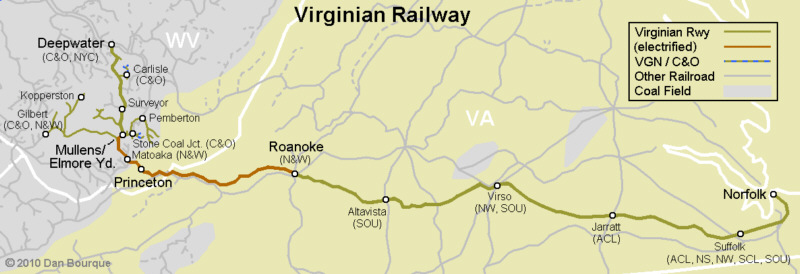
Track Plans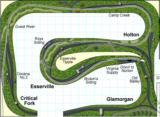 Virginian Track Plans Virginian Track Plans |
Photos | Models |
History
The Virginian was a relative latecomer to the coal fields as its 441 mile mainline from Norfolk, Virginia to Deepwater, West Virgina wasn’t completed until 1909. The Virginian was the result of a 1907 merger between the Deepwater Railway in the coal fields and the Tidewater Railway out of Hampton Roads, VA. The two worked together to build a connection and gain a railroad which directly competed with coal-field giants Norfolk & Western and Chesapeake & Ohio in hauling coal from southern West Virginia to the port of Hampton Roads. Despite its powerful neighbors, the Virginian became a prosperous Class I railroad which enjoyed a mainline built to better standards than its competitors to haul its principle commodity of coal.
To aid in its efficiency in hauling coal over its highest point at Clarks Gap, WV, near Matoaka (and to relieve the health hazards to crews posed by the tunnels), the Virginian electrified 132 miles of mainline from Mullens, WV to Roanoke, VA in the mid-1920s. Steam, and later diesels, ruled the coal fields and the eastern mainline, but electrics did nearly all the work between Mullens and Roanoke. Interestingly, the electrification created a distinct split in the Virginian’s motive power during the diesel era. The coal fields and Princeton-Deepwater main beyond Mullens were the territory of the Virginian’s 25 powerful H24-66 Trainmasters, and the mainline east of Roanoke was home to the 40 smaller H16-44 baby Trainmasters (who also did a bit of switching west of Roanoke). The middle was dominated by the older electric EL-3A boxcabs, streamlined EL-2Bs and squatty but powerful EL-Cs. All the locomotives, however, were maintained by the Virginian’s shops at Princeton, WV.
The Virginian was a profitable venture, even though it was a single-commodity railroad. Connections with the N&W and C&O at Gilbert, WV and the C&O and New York Central at Deepwater yielded a little non-coal traffic, but black diamonds accounted for 90-95% of the tonnage hauled with most of it heading to the Virginian’s two large coal piers at Sewells Point in Norfolk. In fact, the other connections mainly served as western outlets for the coal loaded on the Virginian instead of sources of bridge traffic. After many decades of prosperity, the Virginian was merged into the Norfolk & Western on December 1st, 1959.
Coal Lines and Operations
 The Virginian’s New River Division (all tracks west of Roanoke, VA) held all of the Virginian’s coal lines. The heart of Virginian coal operations was Elmore Yard, adjacent to Mullens, WV. From Elmore, lines branched out in four directions: north (railroad west) to Deepwater, WV; west along the Guyandot River to Gilbert, WV; northeast up the Winding Gulf toward Pemberton, WV; and east to Clarks Gap, WV (mainline to Norfolk). All of these lines were teeming with coal.
The Virginian’s New River Division (all tracks west of Roanoke, VA) held all of the Virginian’s coal lines. The heart of Virginian coal operations was Elmore Yard, adjacent to Mullens, WV. From Elmore, lines branched out in four directions: north (railroad west) to Deepwater, WV; west along the Guyandot River to Gilbert, WV; northeast up the Winding Gulf toward Pemberton, WV; and east to Clarks Gap, WV (mainline to Norfolk). All of these lines were teeming with coal.
Elmore Yard. The yard at Elmore, WV was crammed into a narrow valley. To the north (railroad west) of the yard was the town of Mullens. Mullens was best known for its large brick motor barn residing in the wye dividing the Winding Gulf lines from the Deepwater main. The barn was the end of the line for the electrics and home for the Trainmasters used for helpers, mine runs and mainline trains to Deepwater. The steam facilities were located at the south (railroad east) end of Elmore Yard adjacent to a second wye which allowed departing trains to head west to Gilbert, WV or east to Clarks Gap and Norfolk.
Deepwater District. The Virginian mainline continued beyond Elmore and headed north to a connection with the C&O, and later the NYC, at Deepwater, WV. The Virginian ran time freights 71/72 in cooperation with the NYC and 73/74 to connect with the C&O, but coal remained the primary reason for the line’s existence. Several coal branches stemmed from the mainline including the long Glen Rogers Branch to Glen Rogers which included the Bolt Branch and Laurel Branch, the Beards Fork Branch near Deepwater, and several shorter branches. The Virginian and C&O criss-crossed in this area resulting in jointly owned lines such as the White Oak Railway which connected with the C&O at Carlisle and trackage rights over the Kanawha, Glen Jean & Eastern (KGJ&E–later owned by the C&O) via a connection at Pax, WV. Mine runs operated out of Elmore and a small yard at Page, WV near Deepwater. Additionally, a Virginian (and later an N&W) switcher was stationed in Oak Hill, WV to serve the White Oak Railway.
Guyandot River Branch. The Guyandot River line extended from Elmore to Gilbert, WV (about 42 miles) where it connected with the N&W and later the C&O. It was built primarily as an outlet for westbound coal, but it hosted a pair of branchlines and several online tipples. The largest branch was the Morri Branch which extended from the mainline at Simon Jct. to a large mine at Kopperston. About halfway up the line was the short Huff Creek Branch. The Cub Creek Branch lay between the Morri Branch and Gilbert and also served a handful of loaders. Mine runs originated out of Elmore, though in the N&W era, a small yard and mine run base was built at Plunketts on the Morri Branch. This line also saw some C&O traffic in the 1960s after the C&O secured trackage rights from Gilbert to Pemberton as a condition of the N&W’s merger with the Virginian, but the C&O trains were short-lived. In 1974, several miles of the mainline and branches were realigned to make way for the Bailey Dam project.
Winding Gulf. The Virginian’s first major coal branches were built north of Elmore in the Winding Gulf area. The Winding Gulf Branch began at Mullens and went 34 miles to Willabet with the Stone Coal Branch splitting off at Amigo, a few miles from Mullens. The C&O also served the Winding Gulf area via an extension of its Piney Creek Sub from Raleigh, WV, and several of the tipples in the Gulf were built to load over both Virginian and C&O tracks. The C&O and Virginian interchanged primarily at Pemberton, WV, along the Winding Gulf Branch, but a substantial bit of interchange was also done at Stone Coal Jct., the end of the C&O’s branch and its junction with the Virginian’s Stone Coal Branch. Technically, the C&O (and later the CSX), had trackage rights over the branch, but in reality, the Virginian crews (and later N&W and NS crews) were the only ones who worked the tipples. Likewise, the Virginian had trackage rights over the C&O’s line to Beckley and Cranberry, WV, but C&O crews were the ones who worked the tipples and interchanged the coal at Pemberton. The Virginian’s Winding Gulf Branch mine runs primarily originated out of Elmore, though early in the Virginian’s history, and then again on the N&W during the coal boom of the ’70s, mine runs operated out of Pemberton as well.
Elmore to Clarks Gap. The majority of the Virginian’s coal ended up back at Elmore for the trip to the coal piers at Norfolk. To get there required trains to conquer the 13 miles of 2% grades through tunnels and over spectacular steel trestles to the summit at Clarks Gap. Pushers were a must, and at least in the diesel era, the Virginian typically had electrics on the front end and H24-66 diesels shoving on the rear. Mainline trains were kept short for the push, but for every two trains to Princeton (on the way to Norfolk), a third “Hill Run” would take the hill and set off its cars at Clarks Gap. Mainline trains would drop their helpers at Clarks Gap and pick up half of the train set off by the previous Hill Crew. This practice was maintained through the N&W era and into the NS era, though diesels replaced the electrics in the early ’60s. This action kept the double-track mainline busy enough, but there were also plenty of tipples along the main including the large loaders Tralee and Deerfield, and smaller ones at Tierney and Herndon. These would be worked by a mine run out of Elmore.
Coal was the sole reason for the Virginian’s existence, and throughout its history, it served the coal fields of southern West Virginia well.
Related Products:
Sources:
- The Virginian Era by Lloyd Lewis: TLC Publishing
- Virginian Rails 1953-1993 by Kurt Reisweber: Old Line Graphics




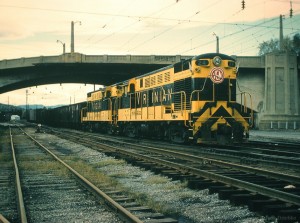
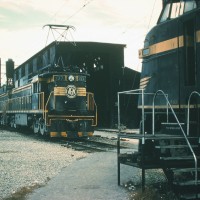 Virginian Photos Page
Virginian Photos Page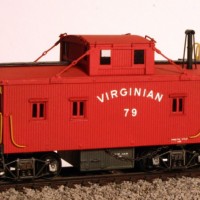 Virginian Models Page
Virginian Models Page